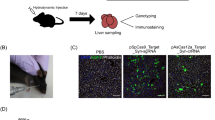Abstract
Adeno-associated virus (AAV) vectors are attractive tools for gene transfer to the liver and are used as gene therapeutic drugs for inherited disorders. The intravenous injection of an AAV vector harboring the gene of interest driven by the hepatocyte-specific promoter could efficiently express the target gene in liver hepatocytes. The delivery of genome editing tools including Cas9 and gRNA, by the AAV vector, can efficiently disrupt the target gene expression in the liver in vivo by intravenous administration in mice. We can quickly obtain mice lacking specific gene expression in the liver only by administering the AAV vector. The method could be suitable for developing genome editing treatments for inherited disorders and basic research exploring the physiological role of the target gene produced from liver hepatocytes.
Access this chapter
Tax calculation will be finalised at checkout
Purchases are for personal use only
Similar content being viewed by others
References
Wagner HJ, Weber W, Fussenegger M (2021) Synthetic biology: emerging concepts to design and advance adeno-associated viral vectors for gene therapy. Adv Sci 8:2004018. https://doi.org/10.1002/advs.202004018
Brown KE (2010) The expanding range of parvoviruses which infect humans. Rev Med Virol 20:231–244. https://doi.org/10.1002/rmv.648
Ogden PJ, Kelsic ED, Sinai S, Church GM (2019) Comprehensive AAV capsid fitness landscape reveals a viral gene and enables machine-guided design. Science 366:1139–1143. https://doi.org/10.1126/science.aaw2900
Srivastava A (2016) In vivo tissue-tropism of adeno-associated viral vectors. Curr Opin Virol 21:75–80. https://doi.org/10.1016/j.coviro.2016.08.003
Zaiss AK, Muruve DA (2008) Immunity to adeno-associated virus vectors in animals and humans: a continued challenge. Gene Ther 15:808–816. https://doi.org/10.1038/gt.2008.54
Wu Z, Yang H, Colosi P (2010) Effect of genome size on AAV vector packaging. Mol Ther 18:80–86. https://doi.org/10.1038/mt.2009.255
Ran FA, Cong L, Yan WX et al (2015) In vivo genome editing using Staphylococcus aureus Cas9. Nature 520:186–191. https://doi.org/10.1038/nature14299
Thakore PI, Kwon JB, Nelson CE et al (2018) RNA-guided transcriptional silencing in vivo with S. aureus CRISPR-Cas9 repressors. Nat Commun 9:1674. https://doi.org/10.1038/s41467-018-04048-4
Ohmori T, Nagao Y, Mizukami H et al (2017) CRISPR/Cas9-mediated genome editing via postnatal administration of AAV vector cures haemophilia B mice. Sci Rep 7:4159. https://doi.org/10.1038/s41598-017-04625-5
Grieger JC, Choi VW, Samulski RJ (2006) Production and characterization of adeno-associated viral vectors. Nat Protoc 1:1412–1428. https://doi.org/10.1038/nprot.2006.207
Baatartsogt N, Kashiwakura Y, Hayakawa M et al (2021) A sensitive and reproducible cell-based assay via secNanoLuc to detect neutralizing antibody against adeno-associated virus vector capsid. Mol Ther Methods Clin Dev 22:162–171. https://doi.org/10.1016/j.omtm.2021.06.004
Ohmori T (2020) Advances in gene therapy for hemophilia: basis, current status, and future perspectives. Int J Hematol 111:31–41. https://doi.org/10.1007/s12185-018-2513-4
Acknowledgment
This work was supported by the Japan Agency for Medical Research and Development (AMED) (JP20fk0410017, JP21am0401005, JP21ae0201007, JP21fk0410037). We thank Yaeko Suto, Mika Kishimoto, Tamaki Aoki, Sachiyo Kamimura, Mai Hayashi, Yuiko Ogihara, Nagako Sekiya, Tomoko Noguchi, and Hiromi Ozaki (Jichi Medical University) for technical assistance. Figures 1, 2, and 4 were prepared by BioRender.com.
Author information
Authors and Affiliations
Corresponding author
Editor information
Editors and Affiliations
Rights and permissions
Copyright information
© 2023 The Author(s), under exclusive license to Springer Science+Business Media, LLC, part of Springer Nature
About this protocol
Cite this protocol
Kashiwakura, Y., Ohmori, T. (2023). Genome Editing of Murine Liver Hepatocytes by AAV Vector-Mediated Expression of Cas9 In Vivo. In: Hatada, I. (eds) Genome Editing in Animals. Methods in Molecular Biology, vol 2637. Humana, New York, NY. https://doi.org/10.1007/978-1-0716-3016-7_15
Download citation
DOI: https://doi.org/10.1007/978-1-0716-3016-7_15
Published:
Publisher Name: Humana, New York, NY
Print ISBN: 978-1-0716-3015-0
Online ISBN: 978-1-0716-3016-7
eBook Packages: Springer Protocols




